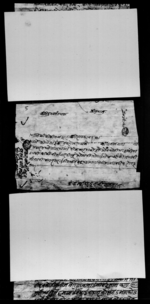A copy of a rukkā from King Raṇabhīma Śāha to Bhuvaneśvaranātha confirming a land grant in Sīsavā (VS 1854)
ID: K_0123_0050
Edited and
translated by Christof Zotter
Created: 2019-01-23;
Last modified: 2019-03-25
For the metadata of the document, click here
The accompanying edition, translation/synopsis and/or commentary are available under the terms of the Creative Commons Attribution-ShareAlike 4.0 International License
Abstract
The rukkā of which the present document is a copy confirms the right of Gosāī̃ Bhuvaneśvaranātha to enjoy a village named Sīsavā in Sunāra as a birtā.Diplomatic edition
[1r]
⟪15⟫1श्रीसिद्धभगवंतनाथ•1श्रीवुवाज्यु• [seal of the Sunāra Māla] ⟪1नकलदुरुस्तछ⟫नकल [seal of Lokanātha] 1सकल्वमोजींनकल्•2दुरुस्तछभनीसही•छा
3प गर्नेलोकनाथ¯¯1स्वस्तिश्रीश्रीश्रीमन्महाराजाधिराजकस्यरुक्का¯¯¯¯¯¯¯¯¯¯¯¯
2आगे•श्रीगोसाँई[?]•भुवणेस्वरनाथके• ¯ ¯ ¯कासिवस्नजादा¯ ¯ ¯ला
3ईसुनारमध्ये•सीसव़ागाँऊभीकचराय़ाकोहो•सोवमोजीम•हांमीवा
4टपनीथामी•वीर्त्तागरिदीञ्यूंसोजानी•सोगाऊलेचर्च्याकोजगावी
5र्ताजानी•चलन्गर•ईतीसम्वत्१८५४सालमितीआषाडवदी१रोज३
6शुभ्म्¯¯¯¯¯¯¯¯¯¯¯¯
Translation
[1r]
[blank space above the main text:]
51
Venerable (śrī) SiddhaBhagavantanātha
Venerable Father2
[seal of the Sunāra revenue office] 3 The copy is exact.
[at the left margin:]
Copy: [seal of the Lokanātha]4
Attesting that the copy is in accord with the original, Lokanātha.
[main text:]
Hail. [This is] an executive order of the thrice venerable5 king of great kings.
Āge: to Gosāī̃Bhuvanesvaranātha6
[The Venerable Father]7 , when he was [about to] leave to dwell in Kāśī (text: Kāsi), offered a village (named) Sīsavā in Sunāra to [the Venerable Siddha Bhagavantanātha]8 as alms.9 Accordingly, we too have supported [this and] made [the village] a birtā. Take cognizance of it [and] 10 use the land controlled by the village, considering [it as your] birtā.
Tuesday, the 1st of the dark fortnight of Āṣāḍha of the [Vikrama] era year 1854 (1797 CE).11 Auspiciousness.
Commentary
One challenge of royal rukkās—which display only the short title of the king, not his full praśasti—is that the king's identity needs to be determined. According to the NGMPP catalogue card of the present document, it was issued by King Raṇabahādura Śāha. According to the catalogue card of another copy (K_0469_0025), for which the year is mistakenly given as VS 1954, the issuer was King Pṛthvī Vikrama. This document, in any event, was not issued by the king of Nepal12 but by the king of Salyan. According to a phrase in Naraharinātha's edition of the document that is not recorded in the copies available in the NGMPP material,13 the sender of this rukkā was Raṇabhīma Śāha (text: Śrī Raṇabhīmasāha), son of Śrīkṛṣṇa Śāha (text: Śrī Kṛṣnasāhā). As we know from other documents, the latter abdicated the throne in favour of his son in VS 1850 and went to Kāśī (cf. above) to await his death there. 14 The grant of a village in Sunāra by King Śrīkṛṣṇa is also mentioned in the Yogivaṃśāvalī, 15 where it is further related that this land grant (among others) enabled Bhuvaneśvaranātha to build a temple at the samādhi of his guru Bhagavantanātha.16
The copy is attested by Lokanātha and the revenue office (māla) in Sunāra. It was prepared as an attachment to a written statement (likhitam) sent by Lokanātha in VS 1964, Pauṣa gate 11, Friday (see K_0123_0049).

